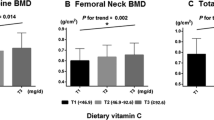Abstract
We investigated the associations of vitamin C, calcium and protein intakes with bone mass at the femoral neck and lumbar spine in postmenopausal Mexican American women. Bone mass was measured by dual-energy X-ray absorptiometry (DXA) and expressed as areal (BMD, g/cm2) and volumetric (bone mineral apparent density or BMAD, g/cm3) bone mineral density. Diet was assessed using a modified version of the National Cancer Institute Food Questionnaire, which was administered by trained bilingual interviewers familiar with Mexican dietary practices. Data gathered from 125 subjects were analyzed using multiple linear regression analysis with age, body mass index (BMI), acculturation, years of estrogen use, physical activity, total energy intake, and the nutrient of interest as independent variables. Neither calcium nor calcium/protein ratio was associated with bone mineral density. There was evidence of a positive association between dietary vitamin C intake and femoral neck BMD (β=0.0002 g/cm2 per mg/day, SE=0.0001,p=0.07) and BMAD (β=0.0001 g/cm3 per mg/day, SE=0.00006,p<0.05), but vitamin C was not associated with lumbar spine bone mass. Further investigation of the role of vitamin C in skeletal health is warranted.
Similar content being viewed by others
References
National Institutes of Health. Final report of the consensus development conference statement: optimal calcium intake. Office of Medical Applications of Research, August 25, 1994.
Heaney RP. Nutrition and risk of osteoporosis. In: Marcus R, Feldman D, Kelsey JL, editors. Osteoporosis. New York: Academic Press, 1996.
Sowers MR, Gladuska DA. Epidemiology of bone mass in premenopausal women. Epidemiol Rev 1993;15:374–96.
Gunnes M, Lehmann EH. Dietary calcium, saturated fat, fiber and vitamin C as predictors of forearm cortical and trabecular bone mineral density in healthy children and adolescents. Act Paediatr 1995;84:388–92.
Leveille S. Dietary antioxidants and postmenopausal osteoporosis [dissertation]. University of Washington, Seattle, WA, 1995.
Hernandez-Avila M, Stampfer MJ, Ravnikar VA, et al. Caffeine and other predictors of bone density among pre- and peri-menopausal women. Epidemiology 1993;4:138–34.
Hall SL, Greendale G. The effect of daily dietary vitamin C intake on bone mineral density in postmenopausal women [abstract]. J Bone Miner Res 1996;11:S103.
Villa ML, Marcus R, Delay RR, Kelsey JL. Factors contributing to skeletal health of postmenopausal Mexican-American women. J Bone Miner Res 1995;10:1233–42.
Katzman DK, Bachrach LB, Carter DR, Marcus R. Clinical and anthropometric correlates of bone mineral acquisition in healthy adolescents. J Clin Endocrinol Metab 1991;73:1332–9.
Block G, Hartman AM, Dresser CM, Carroll MD, Gannon J, Gardner L. A data-based approach to diet questionnaire design and testing. Am J Epidemiol 1986;124:453–69.
Espino DV, Maldonado D, Hypertension and acculturation in elderly Mexican Americans: results from 1982–84 Hispanic HANES. J Gerontol 45:M209-13.
Willett W. Nutritional epidemiology. New York: Oxford University Press, 1990.
Kipp DE, McElvain M, Kimmel DB, Akhter MP, Robinson RG, Lukert BP. Scurvy results in decreased collagen synthesis and bone density in the guinea pig animal model. Bone 1996;18:281–8.
Tsuchiya H, Bates CJ. Ascorbic acid deficiency in guinea pigs: contrasting effects of tissue ascorbic acid depletion and of associated inanition on status indices related to collagen and vitamin D. Br J Nutr 1994;72:745–52.
Thornton PA. Effect of ascorbic acid deprivation in guinea pigs on skeletal metabolism. J Nutr 1968;95:388–92.
Wegger I, Palludan B. Vitamin C deficiency causes hematological and skeletal abnormalities during fetal development in swine. J Nutr 1994;124:241–8.
Kipp DE, Grey CE, McElvain ME, Kimmel DB, Robinson RG, Lukert BP. Long-term low ascorbic acid intake reduces bone mass in guinea pigs. J Nutr 1996;126:2044–9.
Nieves JW, Grisso JA, Kelsey JL. A case-control study of hip fracture: evaluation of selected dietary variables and teenage physical activity. Osteoporos Int 1992;2:122–7.
Michaelsson K, Holmberg L, Mallmin H, et al. Diet and hip fracture risk: a case-control study. Study Group of the Multiple Risk Survey on Swedish Women for Eating Assessment. Int J Epidemiol 1995;24:771–82
The Healthy Eating Index. United States Department of Agriculture. Center for Nutrition Policy and Promotion [CNPP-1], 1995.
Foerster SB, Hudes M, California Dietary Practices Survey: focus on fruits and vegetables. Trends among adults, 1989–1993. Topline Report. Sacramento: California Department of Health Services and California Public Health Foundation, 1994.
Stendig-Lindberg G, Tepper R, Leichter I. Trabecular bone density in a two year controlled trial of peroral magnesium in osteoporosis. Magnesium Res 1993;6:155–63.
Jie K-SG, Gibsbers BLMG, Knapen MHJ, et al. Effects of vitamin K and oral anticoagulants on urinary calcium excretion. Br J Haematol 1993;83:100–4.
Orwoll ES, Oviatt SK, Mann T. The impact of osteophytic and vascular calcifications on vertebral mineral density measurements in men. J Clin Endocrinol Metab 1990;70:1202–7.
National Center for Health Statistics, Centers for Disease Control. Anthropometric data and prevalence of overweight for Hispanics: 1982–84. Washington, DC: US Government Printing Office [Series 11,239. DHHS publication (PHS) 89-1689].
Looker AC, Johnston CC Jr., Wahner HW, et al. Prevalence of low femoral bone density in older US women for NHANES III. J Bone Miner Res 1995;10:796–802.
Alaimo K, McDowell MA, Briefel RR, et al. Dietary intake of vitamins, minerals, and fiber of persons ages 2 months and over in the United States: Third National Health and Nutrition Examination Survey, Phase 1, 1988–1991. Advance data from vital and health statistics no. 258. Hyattsville, MD: National Center for Health Statistics, 1994.
Ballew C, Sugerman SB. High-risk nutrient intakes among low-income Mexican women in Chicago, Illinois. J Am Diet Assoc 1995;95:1409–13.
Author information
Authors and Affiliations
Corresponding author
Rights and permissions
About this article
Cite this article
Wang, M.C., Luz Villa, M., Marcus, R. et al. Associations of vitamin C, calcium and protein with bone mass in postmenopausal Mexican American women. Osteoporosis Int 7, 533–538 (1997). https://doi.org/10.1007/BF02652558
Received:
Accepted:
Issue Date:
DOI: https://doi.org/10.1007/BF02652558




